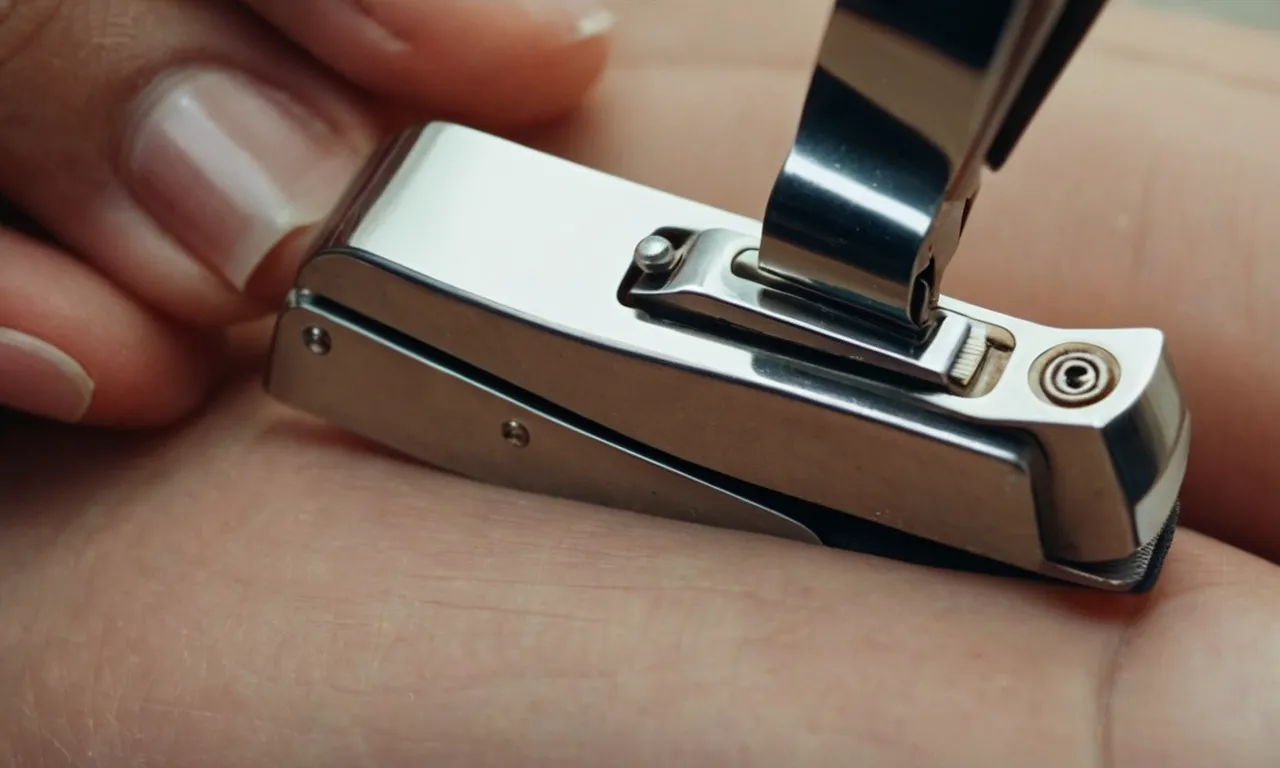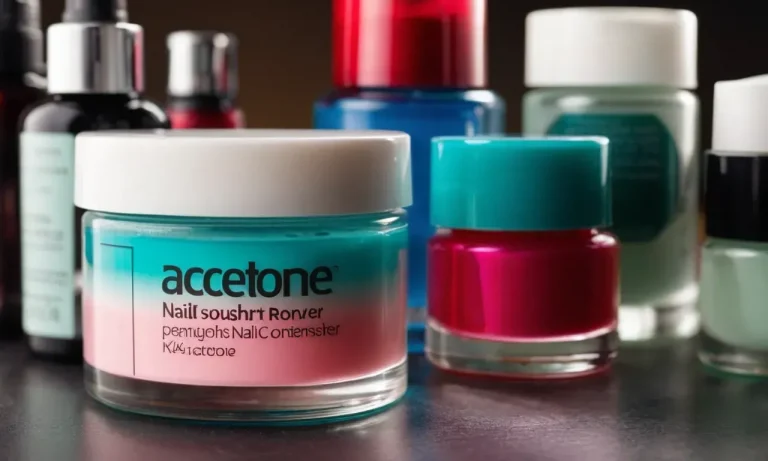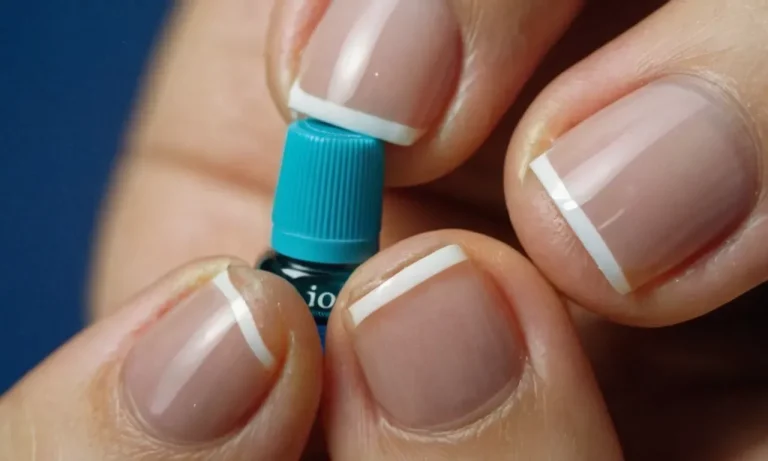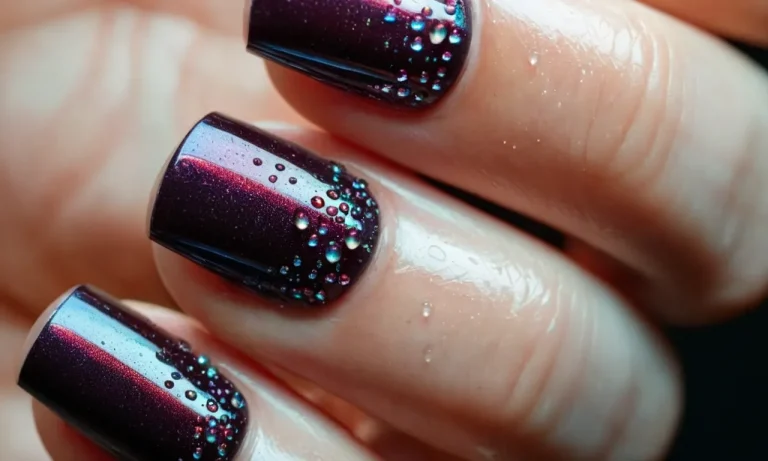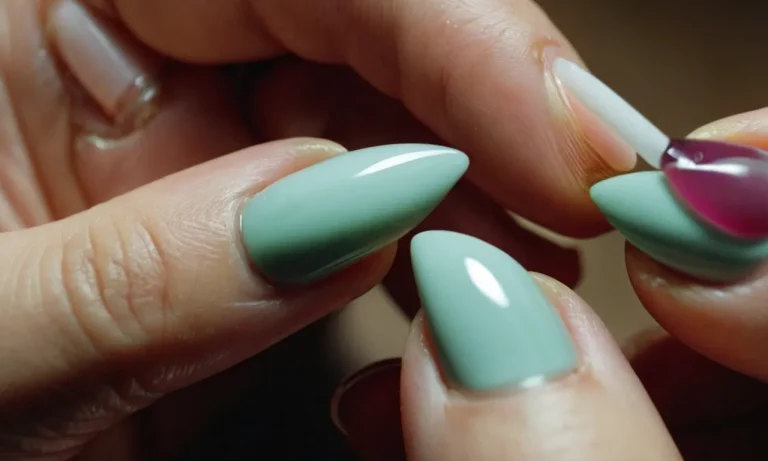How To Cut Ingrown Toenails That Curl Inwards
Ingrown toenails can be extremely painful. If the sides of your toenail grow into the skin on the sides of your toes, it can cause redness, swelling, infection, and make it difficult to walk. Luckily, there are things you can do at home to help alleviate ingrown toenails.
If you’re short on time, here’s a quick answer: Soak your foot in warm water, then lift the corner of the nail growing into the skin using a sterile tool. Trim just the portion growing into the skin using sterilized nail clippers. Apply antibiotic ointment and bandage the area.
In this comprehensive guide, we will cover the causes of ingrown toenails, symptoms to watch for, home treatment options, when to see a doctor, surgical treatments, and prevention tips. With the right information and tools, you can find relief from painful ingrown toenails.
What Causes Ingrown Toenails
Poor Nail Cutting Technique
One of the most common causes of ingrown toenails is improper nail trimming. Cutting your nails too short or rounding the edges can cause the nail corners to dig into the surrounding skin and become ingrown. Ideally, toenails should be cut straight across and not too short to avoid this issue.
Leaving just a tiny bit of white at the nail tips helps reduce irritation.
Heredity
Some people are simply prone to developing ingrown toenails due to the shape and structure of their nails and toes. Those with nails that curve downward at the edges or abnormally wide or thick nails are at an increased risk.
Additionally, if other members of your family frequently deal with ingrown toenails, you may have inherited susceptibility.
Improperly Sized Shoes
Wearing shoes, especially those that are too tight or narrow in the toe box, can cause toenails to become ingrown. The constant pressure against the toes squeezes the skin and pushes it against the nail edges, allowing them to dig in.
Make sure your shoes are wide enough to accommodate your feet without crowding the toes.
Injury or Damage to the Nail
Injuries that cause the nail to separate from the nail bed or toenails that are cracked or damaged can allow the edges to become ingrown more readily. Stubbing your toe, dropping something on your foot, or any trauma that impacts the toenails increases the chances of developing ingrown toenails.
Fungal Infection
A fungal infection, like athlete’s foot, can cause nails to become thickened, brittle, or distorted in shape. As the infection progresses, it may cause swelling and inflammation around the nail as well. These changes make it easier for the nail edges to dig into the skin and become ingrown.
Treating the fungal infection is key to preventing this secondary problem.
Symptoms of an Ingrown Toenail
An ingrown toenail can cause several uncomfortable symptoms. Being able to recognize the signs of an ingrown nail can help you get treatment promptly. Here are some of the most common symptoms of an ingrown toenail:
Swelling
One of the first signs of an ingrown toenail is often swelling around the toe. This occurs as the nail edge digs into the skin and irritates the tissue. The swelling may be mild at first but can increase over time as the condition worsens.
Applying warm compresses can help reduce swelling and discomfort.
Redness
Along with swelling, the area around an ingrown toenail usually becomes red and inflamed. This happens as the skin reacts to the irritation. The redness often spreads outward from the side of the nail. This symptom tends to come and go depending on the severity of the ingrown nail.
Pain
Most people with an ingrown toenail experience significant pain and tenderness. This is because the sharp nail edge cuts into the soft tissue surrounding it. Pain typically gets worse with pressure on the toe, such as when wearing shoes. Taking over-the-counter pain medication can provide relief.
Infection
Since an ingrown nail causes injury to the skin, it’s common for the area to become infected. Signs of infection include increased redness, warmth, throbbing pain, and yellow or green drainage. Infections require medical treatment with antibiotics. Otherwise, they can spread and become serious.
Difficulty Walking
As an ingrown toenail gets worse, it can make walking normally quite difficult. The pain and tenderness in the toe causes people to limp or change their gait. Ingrown nails on both feet can make walking very problematic.
Prompt treatment is key to resolving the ingrown nail and restoring normal function.
Home Treatment for Ingrown Toenails
Soak the Foot
One of the most effective home treatments for ingrown toenails is to soak the affected foot in warm water. This helps soften the nail and reduce inflammation. Fill a basin with warm water and add a teaspoon of salt. Soak the foot for 10-15 minutes, 2-3 times a day.
This can help relax the skin and make it easier to lift the corner of the nail.
Lift the Corner of the Nail
After soaking, gently insert a sterile cotton tip or dental floss under the corner of the ingrown nail. Slowly lift it up and away from the skin. Be very gentle as the area is likely to be sore. This relieves pressure and allows the skin to heal. Do this every time after soaking the foot.
Over a few days, the swelling and pain should improve.
Trim the Nail
Use sterilized nail clippers to carefully trim the toenail. Trim it straight across to avoid pointed edges that can dig into the skin. File the edges smooth with an emery board. Never cut the nail too short as this increases the risk of ingrowth. The best approach is to trim small amounts regularly.
This prevents the buildup of pressure on the skin.
Apply Antibiotic Ointment
After lifting the nail, apply an antibiotic ointment like Neosporin. Using a cotton swab, gently rub it along the side of the nail and skin. This prevents infection which can make the situation much worse. Change the bandage and apply fresh ointment 1-2 times a day.
Bandage the Toe
Bandaging protects the toe and keeps the nail lifted away from the irritated skin. Use a small piece of cotton, gauze, or dental floss to lightly wrap the toe. Be careful not to wrap it too tightly. Changing it once a day allows cleaning and ointment application.
Wear open-toed shoes or sandals until healed to avoid pressure on the toe.
Take Over-The-Counter Pain Relievers
Ingrown toenails can be quite painful. Oral pain medications like acetaminophen (Tylenol) or ibuprofen (Advil) can provide relief. Take according to package directions. Soaking in a warm Epsom salt bath can also relax muscles and reduce soreness.
Apply an ice pack to the toe for 10 minutes several times a day to relieve inflammation.
When to See a Podiatrist
Unbearable Pain
Ingrown toenails can cause mild to severe pain depending on the severity of the condition. If you are experiencing throbbing, shooting or unbearable pain that is not relieved by over-the-counter medications or home treatments, it’s time to see a podiatrist.
A podiatrist can numb the area and remove parts of the nail to provide relief. Leaving an ingrown nail untreated when you are in severe pain increases the risk of infection.
Infection Spreads
Ingrown toenails create an environment prone to bacterial infection. Signs of infection include redness, swelling, pain, heat and discharge containing blood or pus. If you notice spreading redness, swelling or pus, seek medical attention immediately to prevent the infection from becoming serious.
Podiatrists can prescribe oral antibiotics and drain infections if necessary.
Recurring Ingrown Toenails
Some people are prone to chronic ingrown toenails that keep coming back despite home treatment efforts. Recurring ingrown nails cause repeated pain and increase your risk of developing infections. If you have tried soaking and trimming your nails properly but the ingrown toenails persist, it’s in your best interest to visit a podiatrist.
A podiatrist can permanently prevent ingrown toenails from recurring with procedures like partial nail removal or chemical destruction of the nail root.
Diabetes or Poor Circulation
People with diabetes or poor circulation from conditions like peripheral artery disease are at increased risk for complications of ingrown toenails. Without proper blood flow, injuries like ingrown nails heal slowly and can progress to serious foot infections.
Additionally, people with loss of sensation in the feet due to nerve damage may not notice problems with their nails. At the first sign of an ingrown nail, diabetics and those with poor circulation should see a podiatrist to prevent complications.
Can’t Cut the Nail Yourself
Attempting to cut or dig out an ingrown toenail at home can make the problem worse if not done properly. However, some nails become too thickened, curved and embedded in the skin for patients to be able to trim themselves.
If you are unable to adequately trim and relieve pressure from the ingrown nail on your own, consult a podiatrist. The podiatrist can numb the area and safely trim and remove the ingrown portion of the nail.
Medical Treatments for Severe Cases
Partial Nail Removal
Sometimes just a portion of the ingrown toenail needs to be removed to provide relief. This can be done right in your doctor’s office using a local anesthetic to numb the toe. The doctor will use surgical tools to remove the edge of the nail that is growing into the skin.
This allows the nail bed to heal and reduces pain and inflammation. Partial nail removal is a simple, quick procedure that can provide long-lasting relief in many cases of ingrown toenails.
Permanent Nail Removal
For severe or recurring ingrown toenails, your doctor may recommend permanent removal of part or all of the toenail. This prevents the problem from coming back. There are a few different permanent nail removal procedures:
These permanent nail removal procedures require numbing the toe with anesthesia. They are very effective at preventing recurrent ingrown toenails but do result in a narrower or missing nail.
Phenol Treatment
Phenol, also known as carbolic acid, can be used to prevent ingrown toenails from coming back after surgery. After removing part or all of the toenail, the doctor applies a phenol solution to the nail bed.
This causes a chemical cauterization that prevents the nail from growing back in the areas treated with phenol.
One study found that using an 88% phenol solution after total nail matrixectomy significantly reduced the recurrence rate of ingrown toenails (x). However, phenol application can be painful and requires careful administration by a podiatrist or surgeon.
It is an option for patients with severe ingrown toenails who have not found relief from other treatments.
Prevention Tips
Trim Nails Properly
One of the best ways to prevent ingrown toenails is to trim your nails properly. Here are some tips for proper toenail trimming:
- Trim nails straight across, avoiding rounding the edges. Rounded edges encourage the nail to grow into the skin.
- Trim nails to match the contour of your toe. Don’t cut them too short.
- Trim toenails after bathing, when they are soft and pliable.
- Use clean, sharp nail clippers or scissors designed for toenails.
- Trim nails regularly, about once a week.
Wear Correctly Sized Shoes
Wearing shoes that fit properly can help prevent ingrown toenails. Here are some tips for proper footwear:
- Make sure shoes are wide enough and long enough for your feet. Too tight or too short shoes put pressure on nails.
- Avoid narrow toe boxes that squeeze toes together.
- Wear properly fitting athletic shoes for sports and exercise.
- Consider shoes with rounder toe boxes that give toes room.
- Avoid high heels over 2 inches, which shift weight unnaturally.
Apply Petroleum Jelly
Applying petroleum jelly to nails and skin helps soften skin and reduce friction against the nail. Here’s how:
- Apply a thick layer along the side of the nail after bathing and trimming.
- Reapply daily, gently massaging into nail folds.
- You can also apply after soaking feet to lock in moisture.
- Choose pure petroleum jelly without added fragrances.
Consider Toenail Braces
Toenail braces gently lift pressure off ingrown edges. They are thin, flexible braces placed under or over nails.
- Self-adhesive braces stick to nail surface and lift edges.
- Looped braces fit around the toe and lift nail away from skin.
- Silicone braces slide under nails and are reusable.
- Some braces stay on for months until the nail grows out.
- Use braces at first sign of ingrown toenail to prevent infection.
Conclusion
Ingrown toenails can quickly go from mildly uncomfortable to extremely painful. Thankfully, there are many at-home steps you can take to find relief when you notice the early symptoms. With proper home treatment, most mild-moderate cases can be resolved.
In severe or recurring cases, it is best to see a podiatrist. They can surgically remove part or all of the nail to provide permanent relief. With vigilance and proper nail care, you can prevent future ingrown toenails from developing and avoid unnecessary pain and infection.

